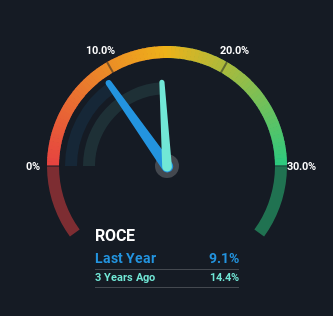Investors Could Be Concerned With HOCHTIEF's (ETR:HOT) Returns On Capital
Did you know there are some financial metrics that can provide clues of a potential multi-bagger? Firstly, we'd want to identify a growing return on capital employed (ROCE) and then alongside that, an ever-increasing base of capital employed. This shows us that it's a compounding machine, able to continually reinvest its earnings back into the business and generate higher returns. Having said that, from a first glance at HOCHTIEF (ETR:HOT) we aren't jumping out of our chairs at how returns are trending, but let's have a deeper look.
Return On Capital Employed (ROCE): What Is It?
For those who don't know, ROCE is a measure of a company's yearly pre-tax profit (its return), relative to the capital employed in the business. Analysts use this formula to calculate it for HOCHTIEF:
Return on Capital Employed = Earnings Before Interest and Tax (EBIT) ÷ (Total Assets - Current Liabilities)
0.091 = €665m ÷ (€19b - €11b) (Based on the trailing twelve months to September 2023).
So, HOCHTIEF has an ROCE of 9.1%. In absolute terms, that's a low return but it's around the Construction industry average of 10%.
Check out our latest analysis for HOCHTIEF

In the above chart we have measured HOCHTIEF's prior ROCE against its prior performance, but the future is arguably more important. If you're interested, you can view the analysts predictions in our free report on analyst forecasts for the company.
What Does the ROCE Trend For HOCHTIEF Tell Us?
In terms of HOCHTIEF's historical ROCE movements, the trend isn't fantastic. Around five years ago the returns on capital were 17%, but since then they've fallen to 9.1%. However, given capital employed and revenue have both increased it appears that the business is currently pursuing growth, at the consequence of short term returns. And if the increased capital generates additional returns, the business, and thus shareholders, will benefit in the long run.
On a related note, HOCHTIEF has decreased its current liabilities to 61% of total assets. That could partly explain why the ROCE has dropped. Effectively this means their suppliers or short-term creditors are funding less of the business, which reduces some elements of risk. Since the business is basically funding more of its operations with it's own money, you could argue this has made the business less efficient at generating ROCE. Keep in mind 61% is still pretty high, so those risks are still somewhat prevalent.
The Key Takeaway
In summary, despite lower returns in the short term, we're encouraged to see that HOCHTIEF is reinvesting for growth and has higher sales as a result. In light of this, the stock has only gained 10% over the last five years. So this stock may still be an appealing investment opportunity, if other fundamentals prove to be sound.
If you want to continue researching HOCHTIEF, you might be interested to know about the 2 warning signs that our analysis has discovered.
While HOCHTIEF may not currently earn the highest returns, we've compiled a list of companies that currently earn more than 25% return on equity. Check out this free list here.
Have feedback on this article? Concerned about the content? Get in touch with us directly. Alternatively, email editorial-team (at) simplywallst.com.
This article by Simply Wall St is general in nature. We provide commentary based on historical data and analyst forecasts only using an unbiased methodology and our articles are not intended to be financial advice. It does not constitute a recommendation to buy or sell any stock, and does not take account of your objectives, or your financial situation. We aim to bring you long-term focused analysis driven by fundamental data. Note that our analysis may not factor in the latest price-sensitive company announcements or qualitative material. Simply Wall St has no position in any stocks mentioned.
